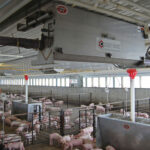Gleaner Super7 Prototype Combine Testing
By Kevin BienAGCO Product Marketing Manager, Combines The Gleaner S7 prototype combine is currently on the Texas to the Dakotas wheat harvest run (see pictures). AGCO is using the black-painted S7 (nicknamed by some as “The Stealth”) machine to provide...
Gleaner Super7 Prototype Combine Testing
By Kevin BienAGCO Product Marketing Manager, Combines The Gleaner S7 prototype combine is currently on the Texas to the Dakotas wheat harvest run (see pictures). AGCO is using the black-painted S7 (nicknamed by some as “The Stealth”) machine to provide... By Kevin Bien
By Kevin Bien
AGCO Product Marketing Manager, Combines
The Gleaner S7 prototype combine is currently on the Texas to the Dakotas wheat harvest run (see pictures). AGCO is using the black-painted S7 (nicknamed by some as “The Stealth”) machine to provide the final round of engineering tests and data collection before the new‑generation Super Series Gleaner combines are introduced to the public.
This year’s wheat run by the S7 is the final chapter in years of development and field testing that is leading to a historic product introduction for the Gleaner transverse rotor combine line.  Gleaner “Natural Flow” harvesting technology has been constantly improved and developed since its 1979 introduction. The new Super Series transverse Gleaners build on these decades of experience while delivering design innovations that will make the Super Series set new standards for capacity, efficiency and productivity. The Super Series Gleaner combines are poised to redefine the performance customers can expect from Class VI and Class VII combines.
Gleaner “Natural Flow” harvesting technology has been constantly improved and developed since its 1979 introduction. The new Super Series transverse Gleaners build on these decades of experience while delivering design innovations that will make the Super Series set new standards for capacity, efficiency and productivity. The Super Series Gleaner combines are poised to redefine the performance customers can expect from Class VI and Class VII combines.
So far on this year’s run, the S7 has harvested in Texas, Oklahoma and Kansas in wheat crops ranging from less than 30 bu./acre to more than 50 bu./acre. Moisture levels have also varied significantly as the S7 has joined a succession of custom harvest crews running both Gleaner and competitive brands of combines. Combine customers and dealers visiting the harvest sites and riding in the S7 are reporting very favorable impressions of the bu./hour harvested, the clean grain samples produced, and the efficient fuel use they are observing.
The S7 will continue to work the wheat harvest for several weeks recording more testing hours, completing more comparison tests and shouldering its part of an annual U.S. wheat harvest that is worth billions of dollars. We will return soon with additional reports from the S7 and the 2010 harvest run.
Want to learn more? Sign up for updates on the Gleaner Super7 .



